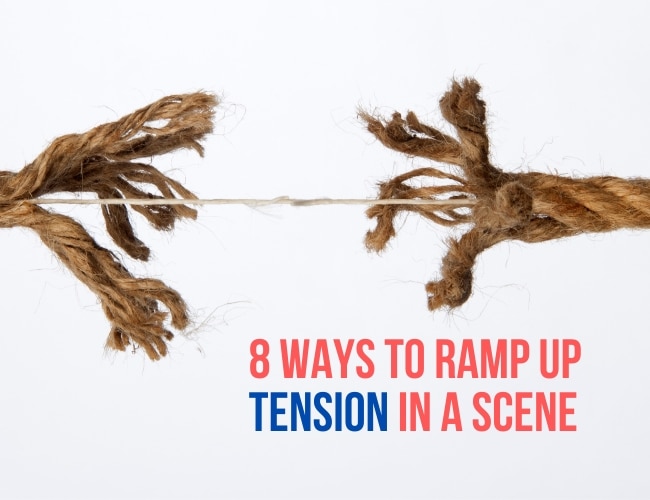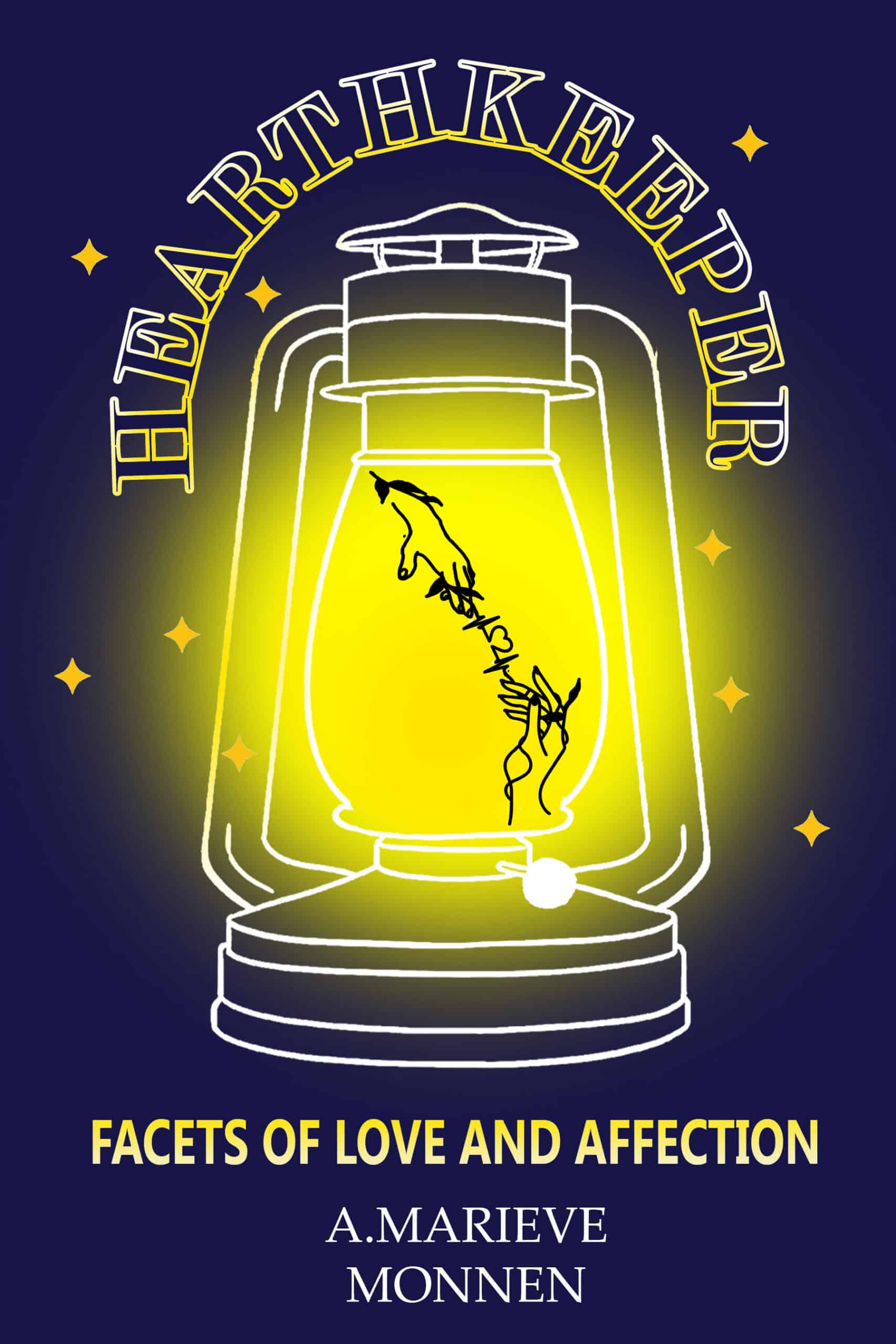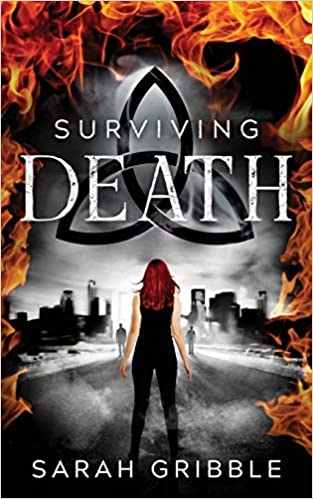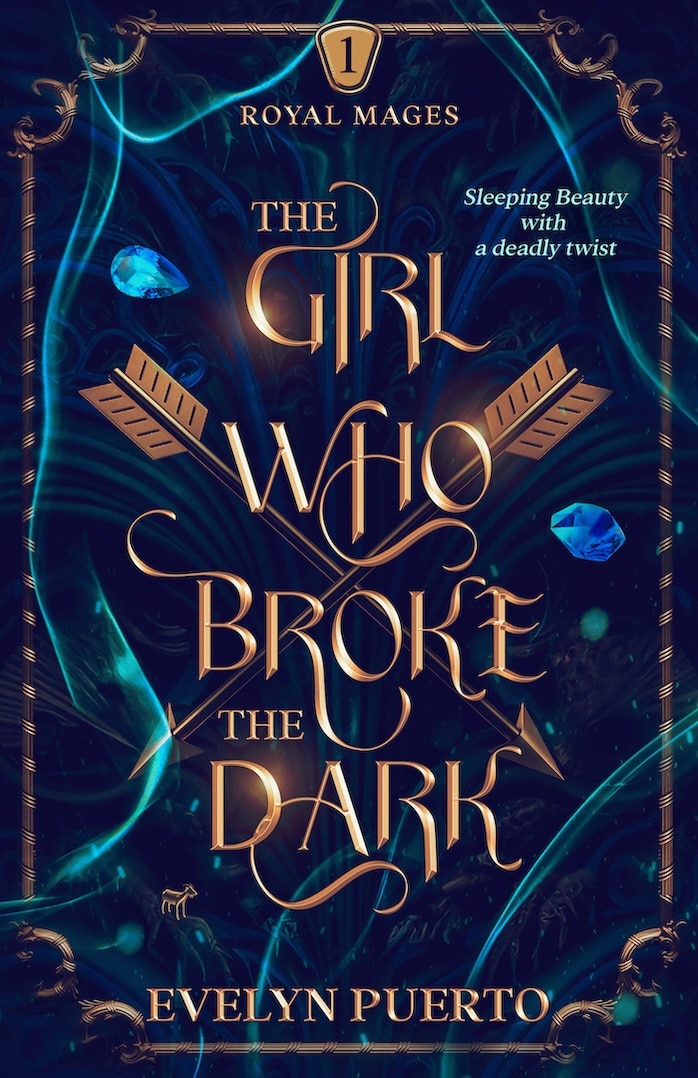Writing tension can be tricky. Have you ever received feedback that a scene is boring or should be cut, but you know that it’s crucial to the overall plot? What do you do? You probably need help writing tension, taking the scene from good to great. Let's look at eight ways to increase the tension in your writing.

Today's article on writing tension is by guest author Taylor Munsell, author of the book Touch of Death. Welcome, Taylor!
Tension in writing produces fear, worry, or anxiousness in the character or reader. It keeps the reader or viewer on the edge of their seat, desperate to know what happens next. It generates an emotional investment in your characters.
Whatever genre of story you’re writing, tension is crucial. And, it’s not only tension in writing as a whole that’s key, but in each scene as well. After all, what's a story without a little conflict, right?
Here are eight tips to help you with writing tension in your scenes. From creating deep POV to changing up the setting, these techniques will help you keep your readers or viewers engaged and emotionally invested.
1. Check Scene Conflict
Okay, before we get into the nitty-gritty of amping up the tension in a scene, let's make sure that the scene itself is actually necessary.
Ask yourself: does this scene move the story forward? Does it reveal something new about the characters or their motivations? Does it raise the stakes in a meaningful way? If the answer to any of these questions is “no,” then it's time to reevaluate whether that scene belongs in your story.
Assuming that the scene does, in fact, need to be there, let's talk about the bones of the scene. Conflict is key here — without it, you've got nothing. This doesn't necessarily mean that your characters need to be at each other's throats, but there needs to be some kind of tension between them.
Maybe they're trying to hide something from each other, or they have conflicting goals that they're trying to achieve. Whatever the case may be, make sure that there's something at stake — something that your characters stand to lose if they fail. Character conflict can be external—conflict with another character or outside force, even a ticking clock.
Or it can be internal conflict—a character at war with themselves. Internal tension can be a quieter moment in a scene where a character battles with conflicting desires or it can be something overwhelming like an emotional wound that's resulted in beliefs or worries that keep the character from acting on their goal.
If you're struggling to come up with conflict, try asking yourself what your characters want and what's standing in their way. What is the external goal in the scene and how can you disrupt it? It's amazing how much tension you can create even in an ordinary scene just by putting obstacles in your characters' paths.
So, before you start worrying about body language and sensory overload and all that fun stuff, take a step back and make sure that your scene has a solid foundation to build on. Once you've got that, it's time to start amping up the tension.
2. Enter Deep POV
Alright, let's talk about getting into your characters' heads. No, I don't mean literally — that would be weird, even for me. But seriously, it's important to get inside your characters' heads and figure out what they're really thinking and feeling. Because let's face it, nobody ever says what they're actually thinking. That's just not how humans work.
So, how do you get into deep point of view (a.k.a POV)? Well, remember those stakes we just talked about? This is where they come in. Stakes are what a character stands to gain or lose in any scene. Effective stakes are emotional because the character wants a certain outcome and that creates a sense of tension.
So part of what you want to uncover is why the stakes create an emotional reaction in your character. Deep POV shifts from narrating the character's reaction to showing the character's thinking and why the stakes matter.
Start thinking about how your character would react to the situation. What emotions are they feeling? Are they anxious, angry, scared, excited? How do those emotions manifest themselves physically? Do they clench their jaw? Tap their foot? Chew on their fingernails?
And remember, not everything your character is feeling is going to be expressed out loud. Maybe they're feeling guilty, but they don't want to admit it to the other characters. Or maybe they're hiding a secret that's eating away at them. Whatever the case may be, make sure you're conveying those internal struggles to the reader.
Don't be afraid to get a little introspective with your characters. Figure out what's really going on in their heads and use that to ratchet up the tension in your scene.
3. Get Physical
Ah, body language. The unspoken language of the human race. It's amazing how much tension you can create just by the way your characters hold themselves, or the way they move.
Let's say you're writing a scene where your main character is about to confront their nemesis. You could just have them stand there, staring each other down, and hope that the dialogue carries the tension. But that's not going to cut it, my friend. You need to show us the tension.
Using body language to convey tension can be part of deep POV, but it isn’t limited to your narrator. The physical language of the other characters in the scene can also be used to build tension.
Maybe another character starts tapping their foot or pacing while your character is talking indicating their impatience with the character speaking. Or maybe they freeze up, completely paralyzed by fear or anger. Whatever it is, make sure it's something that's going to get the reader's heart racing.
Another great way to show tension is through eye contact. You know that feeling when you're in a staring contest and you just can't look away? That's the kind of tension we're talking about here. Maybe your characters lock eyes and refuse to break the gaze, even when things start to get uncomfortable. Or maybe they're avoiding eye contact altogether, which could be a sign that something's not quite right.
And let's not forget about other non-verbal cues, like sweating, fidgeting, or even blushing. All of these things can be signs of tension, and they're great ways to show your characters' inner turmoil without having to spell it out for the reader.
Show us the tension through their body language and other non-verbal cues, and you'll have your readers on the edge of their seats, wondering how the character is going to deal with the source of tension.
4. Use the Senses
It’s time to think about the senses. No, not like the sense of fashion or the sense of humor. I mean, like the five senses: sight, sound, smell, taste, and touch. How can we use sensory language to make a scene more tense?
First up, try overloading the characters’ senses. Imagine your character is in a busy, crowded street market. There are people everywhere, shouting and haggling over prices, and the smell of spices is so strong it feels like it's stuck in their nose hairs.
Throw in some uneven cobblestones underfoot and maybe some stray animals, and your character is feeling pretty overwhelmed. By overloading the senses, you can make the reader feel just as tense and on-edge as the character.
On the other hand, sensory deprivation can also be a useful tool. Imagine a character trapped in a small, pitch-black room. They can't see anything, hear anything, or even feel anything except the cool, smooth walls. The complete lack of sensory input can be just as tense as an overload of stimuli.
Choose sensory details that matter to the type of tension or conflict that your character is facing, and use the senses to your advantage in the scenes where they make the most difference.
Just be careful not to overload your reader with too many sensory details, or they might start feeling overwhelmed too!
5. Don’t Forget Dialogue
Ah, dialogue. That beautiful symphony of words, dripping with subtext and hidden meanings. A great way to crank up tension in a scene.
One dialogue technique to build tension is veiled language. You know, when characters say one thing but mean another. It's like a game of verbal chess, where the winner gets to walk away with their dignity (and hopefully, their life) intact.
Let's say you've got a scene where two old friends are catching up. Seems harmless enough, right? But what if one of them is secretly a spy, and the other is unwittingly giving away classified information?
Suddenly, every seemingly innocent comment takes on a whole new meaning. Is “How's your job these days?” just a friendly question, or a subtle way of asking if they're still working for the government?
The tension mounts with each line of dialogue. It doesn’t need to be their occupation though. Your character may have ulterior motives for digging for information, maybe that’s to see if anyone knows one of their secrets or to catch someone else in a lie. Whatever the ulterior motive is, it needs to be specific to your book, your plot, and that particular scene.
And then there's the classic misunderstanding. You know the drill: one character says something, the other character interprets it in the worst possible way, and chaos ensues. It's like a comedy of errors, except instead of laughs, you get heart palpitations.
Remember, dialogue is not just for exposition and witty banter. Use it to ratchet up the tension, and watch your readers squirm in their seats.
6. Change the Setting
Changing up the location: one of the oldest tricks in the book for creating tension. Because, let's be honest, the location can be just as important as the characters in a scene. Sometimes, even more so.
Think about it. A romantic candlelit dinner at a fancy restaurant? Pretty tense, but for all the right reasons. A candlelit dinner in a spooky abandoned mansion? Pretty tense, but for all the wrong reasons.
The location can set the mood and raise the stakes. So, if you're looking to ramp up the tension in a scene, try changing up the setting. Maybe move the conversation from a quiet, peaceful park to a loud, crowded concert. Or take it from a spacious office to a cramped, cluttered closet.
Get creative. Maybe your characters have a serious conversation while hanging off the side of a cliff. Or maybe they're trapped in an elevator with their biggest fear. The possibilities are endless.
Just remember, the location should serve a purpose. It should create a tense scene and help move the story forward. Don't just throw your characters into a random, uncomfortable space for no reason. Unless, of course, you're Ryan Murphy and you're making American Horror Story.
So, go ahead and switch things up. Move the conversation to a new location and see how it changes the dynamic. And if you need inspiration, just remember that even Darth Vader and Luke Skywalker had their epic showdown in a cramped, claustrophobic space.
7. Throw a Curveball
Listen, we all love a good twist, right? But sometimes the best twists are the ones you don't see coming. So, when you're trying to ramp up the tension in a scene, throw the reader a curveball. Lead them down one path, and then suddenly, BOOM! Take them in a completely different direction.
For example, let's say you've set up a scene where two characters are about to have a tense confrontation. The reader is expecting a heated argument, maybe even a physical fight. But instead, one character suddenly breaks down in tears, revealing a vulnerability the reader never saw coming.
Or maybe the characters are in a high-stakes situation, and the reader expects the protagonist to make a heroic sacrifice. But instead, the protagonist decides to save themselves and leave everyone else behind.
These kinds of curveballs can be really effective at creating emotional tension because they subvert the reader's expectations. It's like a little mind game — the reader thinks they know what's going to happen, and then you pull the rug out from under them.
But here's the thing: you can't just throw a curveball for the sake of throwing a curveball. It has to make sense for the story and the characters. And you can't rely on it too heavily, or it'll start to feel like a cheap trick. But used sparingly and effectively, a curveball or plot twist can be a powerful tool for ramping up the tension in your scene.
8. Look at Syntax and Diction
Last but not least: syntax and diction. This is where things get a little technical. But don't worry, I'll try to keep it interesting.
One way to amp up the tension in a scene is by paying attention to the syntax and diction. I mean things like sentence structure, paragraph breaks, and word choice.
For example, short sentences can be used to create a staccato, urgent rhythm that ramps up the tension. Longer, more complex sentences, on the other hand, can slow things down, giving the reader a chance to catch their breath.
Paragraph breaks can also be used to great effect. Short, punchy paragraphs can help build momentum, while longer paragraphs can be used to slow things down, giving the reader time to process what's happening.
And of course, diction, or word choice, is key. The right word can make all the difference in creating tension. For example, using a word with negative connotations can give the reader a sense of unease or foreboding. Using a word with positive connotations in a tense moment can create a sense of cognitive dissonance, adding to the tension.
So, as you're working on your scene, pay attention to the syntax and diction. Experiment with sentence length and paragraph breaks. Play around with word choice. You might be surprised at how much of a difference it can make.
Writing Tension: Be Selective
There you have it, folks. Eight ways to ramp up the tension in a scene. Now, I'm not saying you should use all eight in one scene, that might cause your readers to have a heart attack. But mix and match. Try a few out and see what works best for your story.
Again, not every tip will work for every scene. It's all about finding the right balance for your story and your characters. Take a hard look at your scene and ask yourself which tip will work best for that scene. But, most importantly, have fun with it.
What keeps you on the edge of your seat as a reader? Share in the comments.
Practice
Set your timer for fifteen minutes. Identify one of your scenes that needs the tension ramped up. In one or two of the paragraphs, try out one or more of these tips. See if it helps to ramp up the tension and make the scene more engaging. And, of course, don't forget to have fun with it.
When you're finished, post your practice Pro Practice Workshop here (and if you’re not a member yet, you can join here). And if you post, be sure to leave feedback on a few practices by other writers.
This article is by a guest blogger. Would you like to write for The Write Practice? Check out our guest post guidelines.



Thanks, I found this helpful. One not mentioned was weather. Cliched, but still works.